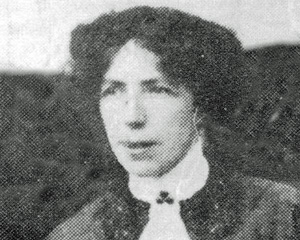Cissie Cahalan facts for kids
Quick facts for kids
Cissie Cahalan
|
|
|---|---|
 |
|
| Born | 1876 |
| Died | 27 August 1948 (aged 71–72) |
| Nationality | Irish |
| Occupation | Shop worker |
| Known for | Activism as trade unionist, feminist, and suffragette |
Cissie Cahalan (1876 – 27 August 1948) was an important Irish woman. She was a trade unionist, a feminist, and a suffragette. This means she worked hard to improve conditions for workers. She also fought for women's rights and campaigned for women to get the right to vote. Cissie Cahalan made a big difference for shop workers in Ireland.
Her Life and Work
Cissie Cahalan was born in 1876. She grew up in either Cork or Tipperary, Ireland. Her father was a school teacher. Cissie later worked in shops in Dublin, especially at a large department store called Arnotts.
Fighting for Women's Rights
Cissie was very active in movements that fought for change. From 1908, she was a member of the Irish Drapers' Assistants' Association (IDAA). This was a trade union that helped shop workers. She also joined the Irish Women's Franchise League (IWFL). This group worked to get women the right to vote.
Cissie Cahalan was special because she was one of the few working-class women to play a big role in the Irish movement for women's voting rights.
In 1912, she led the "Ladies Committee" for the IDAA in Dublin. She also wrote for the union's newspaper. That same year, she asked the Dublin Trades' Council to support women's suffrage. This means she wanted women to have the right to vote. She was representing the IWFL when she did this. Cissie was part of the IWFL's main committee from 1917 to 1918. She also served as the secretary for the Irish Women's Franchise League at one point.
Improving Workers' Lives
In 1917, Cissie Cahalan went to the Irish Trades Union Congress. She was there as a representative for the IDAA. While working at Arnotts, she led a strike to get better pay. A strike is when workers stop working to demand better conditions. She succeeded, and the workers won a 30% pay raise!
Cissie was elected president of the IDAA three times: in 1922, 1923, and 1924. As part of the IDAA, she successfully campaigned for a minimum wage. This is the lowest amount of money an employer can legally pay a worker. She was also on the IDAA's executive committee from 1922 to 1923. However, she left the committee because she felt the union wasn't doing enough about certain issues.
Cissie continued her day job and her activist work until 1932. She also worked part-time at St Ultan's Hospital. She kept writing for the union's newspaper in the 1930s. In 1932, she married John Burns, who passed away four years later. Cissie was good friends with Hanna Sheehy-Skeffington, another important Irish activist. Cissie Cahalan died on 27 August 1948.
Her Beliefs
Cissie Cahalan had strong beliefs about how trade unions should work. In 1919, she had a public discussion with another suffragist named Louie Bennett. They debated whether women should have their own separate unions or join unions with men. This debate happened in a newspaper called The Irish Citizen.
Louie Bennett thought women should have separate unions. But Cissie Cahalan believed in unions that included both men and women. She felt that if women didn't take on leadership roles, it was their own responsibility. Cissie also argued that separate unions for women could make it easier for bosses to cause problems during disagreements.
In one article, Cissie admitted that when women joined unions, male workers sometimes felt upset because women often earned less. However, she strongly believed that:
Women have allowed themselves to be used by the capitalists as a means of lowering the standard of wages. If women demanded equal pay for equal work we should not have had this antagonism.
This means she thought women should demand the same pay as men for doing the same job. If they did, there would be less conflict between male and female workers.
Cissie Cahalan was also strongly against the First World War. However, she saw it as a chance to make working conditions better for women. She joined the Women’s Employment Committee to help with this. She believed that all workers, men and women, should be part of trade unions. She also campaigned for equal pay for equal work for everyone.

